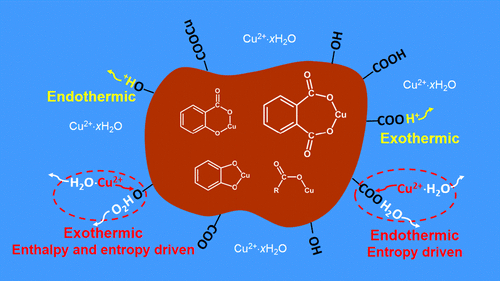当前位置:
X-MOL 学术
›
Environ. Sci. Technol.
›
论文详情
Our official English website, www.x-mol.net, welcomes your
feedback! (Note: you will need to create a separate account there.)
Proton and Copper Binding to Humic Acids Analyzed by XAFS Spectroscopy and Isothermal Titration Calorimetry
Environmental Science & Technology ( IF 10.8 ) Pub Date : 2018-03-21 00:00:00 , DOI: 10.1021/acs.est.7b06281 Jinling Xu 1, 2 , Luuk K. Koopal 3, 4 , Linchuan Fang 1 , Juan Xiong 3 , Wenfeng Tan 1, 3
Environmental Science & Technology ( IF 10.8 ) Pub Date : 2018-03-21 00:00:00 , DOI: 10.1021/acs.est.7b06281 Jinling Xu 1, 2 , Luuk K. Koopal 3, 4 , Linchuan Fang 1 , Juan Xiong 3 , Wenfeng Tan 1, 3
Affiliation

|
Proton and copper (Cu) binding to soil and lignite-based humic acid (HA) was investigated by combining X-ray absorption fine structure (XAFS) spectroscopy, isothermal titration calorimetry (ITC), and nonideal-competitive-adsorption (NICA) modeling. NICA model calculations and XAFS results showed that bidentate and monodentate complexation occurred for Cu binding to HA. The site-type-specific thermodynamic parameters obtained by combining ITC measurements and NICA calculations revealed that copper binding to deprotonated carboxylic-type sites was entropically driven and that to deprotonated phenolic-type sites was driven by entropy and enthalpy. Copper binding to HA largely depended on the site-type and coordination environment, but the thermodynamic binding mechanisms for Cu binding to the specific site-types were similar for the different HAs studied. By comparing the site-type-specific thermodynamic parameters of HA–Cu complexation with those of low molar mass organic acids, the Cu coordination could be further specified. Bidentate carboxylic–Cu complexes made the dominating contributions to Cu binding to HA. The present study not only yields molecular-scale mechanisms of ion binding to carboxylic- and phenolic-type sites of HA but also provides the new insight that the universal nature of site-type-specific thermodynamic data enables quantitative estimation of the binding structures of heavy metal ions to humic substances.
中文翻译:

XAFS光谱和等温滴定量热法分析质子和铜与腐殖酸的结合
通过结合X射线吸收精细结构(XAFS)光谱,等温滴定量热法(ITC)和非理想竞争吸附(NICA)建模研究了质子和铜(Cu)与土壤和褐煤基腐殖酸(HA)的结合。NICA模型计算和XAFS结果表明,铜与HA的结合发生了双齿和单齿络合。通过结合ITC测量和NICA计算获得的特定于位点类型的热力学参数表明,铜与去质子化的羧基型位点的结合是熵驱动的,而铜与去质子化的酚型位点的结合是由熵和焓驱动的。铜与HA的结合在很大程度上取决于站点类型和协调环境,但是对于研究的不同HA,Cu结合到特定位点类型的热力学结合机理是相似的。通过比较HA-Cu配合物与低摩尔质量有机酸的位点类型特定的热力学参数,可以进一步指定Cu配位。二元羧酸-铜络合物对铜与HA的结合起了主要作用。本研究不仅产生了离子结合到HA的羧基和酚型位点的分子尺度机制,而且还提供了新的见解,即位点类型特异性热力学数据的通用性使得能够定量估算重质化合物的结合结构。金属离子到腐殖质。可以进一步指定铜的配位。二元羧酸-铜络合物对铜与HA的结合起了主要作用。本研究不仅产生了离子结合到HA的羧基和酚型位点的分子尺度机制,而且还提供了新的见解,即位点类型特异性热力学数据的通用性使得能够定量估算重质化合物的结合结构。金属离子到腐殖质。可以进一步指定铜的配位。二元羧酸-铜络合物对铜与HA的结合起了主要作用。本研究不仅产生了离子结合到HA的羧基和酚型位点的分子尺度机制,而且还提供了新的见解,即位点类型特异性热力学数据的通用性使得能够定量估算重质化合物的结合结构。金属离子到腐殖质。
更新日期:2018-03-21
中文翻译:

XAFS光谱和等温滴定量热法分析质子和铜与腐殖酸的结合
通过结合X射线吸收精细结构(XAFS)光谱,等温滴定量热法(ITC)和非理想竞争吸附(NICA)建模研究了质子和铜(Cu)与土壤和褐煤基腐殖酸(HA)的结合。NICA模型计算和XAFS结果表明,铜与HA的结合发生了双齿和单齿络合。通过结合ITC测量和NICA计算获得的特定于位点类型的热力学参数表明,铜与去质子化的羧基型位点的结合是熵驱动的,而铜与去质子化的酚型位点的结合是由熵和焓驱动的。铜与HA的结合在很大程度上取决于站点类型和协调环境,但是对于研究的不同HA,Cu结合到特定位点类型的热力学结合机理是相似的。通过比较HA-Cu配合物与低摩尔质量有机酸的位点类型特定的热力学参数,可以进一步指定Cu配位。二元羧酸-铜络合物对铜与HA的结合起了主要作用。本研究不仅产生了离子结合到HA的羧基和酚型位点的分子尺度机制,而且还提供了新的见解,即位点类型特异性热力学数据的通用性使得能够定量估算重质化合物的结合结构。金属离子到腐殖质。可以进一步指定铜的配位。二元羧酸-铜络合物对铜与HA的结合起了主要作用。本研究不仅产生了离子结合到HA的羧基和酚型位点的分子尺度机制,而且还提供了新的见解,即位点类型特异性热力学数据的通用性使得能够定量估算重质化合物的结合结构。金属离子到腐殖质。可以进一步指定铜的配位。二元羧酸-铜络合物对铜与HA的结合起了主要作用。本研究不仅产生了离子结合到HA的羧基和酚型位点的分子尺度机制,而且还提供了新的见解,即位点类型特异性热力学数据的通用性使得能够定量估算重质化合物的结合结构。金属离子到腐殖质。











































 京公网安备 11010802027423号
京公网安备 11010802027423号